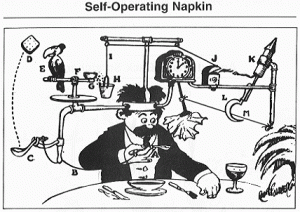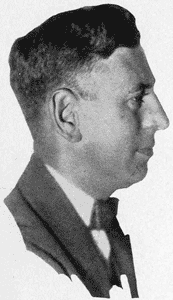I would like you to meet one of my professional heroes. His name was Rube Goldberg and he was born on the 4th July in San Francisco in 1883. He attained a Bachelor of Science degree in engineering from the University of California at Berkley in 1904.
These days he is still an influential figure. He has a dedicated YouTube channel. Hundreds of schools all over the world hold Rube Goldberg design competitions for their physics, engineering and design students. And those students benefit greatly from being asked to solve problems using the principles that Rube Goldberg developed.
The thing I love most about Rube Goldberg is that he didn’t remain an engineer. He became instead, a cartoonist who gently and affectionately poked fun at bad design. He won a Pulitzer prize in 1948.
If you haven’t heard of him, you may still be familiar with his legacy. Did you like the Honda “Isn’t it nice when things just work” (http://www.youtube.com/watch?v=_ve4M4UsJQo&feature=plcp) TV commercial? Did you play mousetrap as a child? Do you have Amazing Alex on your phone or tablet? If so then you know what a Rube Goldberg cartoon looks like.

Rube Goldberg was a bellwether figure. He was born at the right time to be an observer of the machine age. And his life spanned an important change in our relationship to technology.
The late nineteenth and early twentieth century was a golden age for mechanical technology. It was a time when inventor heroes could build a flying machine in their back yard or light the world by inventing the electric bulb. Or when adventures like Amelia Earhart and Charles Lindbergh used technology to make possible their marvellous exploits. Rube Goldberg started his career in an age of tinkering and adventure when the addition of electricity to machines was opening up a new world of opportunities.
It didn’t stay that way. On the 30th of October, 1935 a new long range bomber, the Boeing Model 299 crashed and burst into flames during a test flight at Wright Air Field in Ohio. Two of the five crew died. A subsequent investigation showed there was nothing wrong with the plane. In fact it would later be dubbed ‘the Flying Fortress’. Boeing had designed it to enter a competition being held by the United States Army Air Corps. The Flying Fortress was state of the art. It was built from new aluminium alloys, it had four engines where previous bombers had only two. It could carry five times the payload, at faster speeds, over almost twice the range as the best bombers of the time. And, as Atul Gawande pointed out, it might have been the first plane to crash because it was too advanced.
“An investigation revealed that nothing had gone wrong. The crash had been due to ‘pilot error’ the report said. Substantially more complex than previous aircraft, the new plane required the pilot to attend to the four engines, each with its own oil-fuel mix, the retractable landing gear, the wing flaps, electric trim tabs that needed adjustment to maintain stability at different airspeeds, and constant-speed propellors whose pitch had to be regulated with hydraulic controls, among other features.”
– Atul Gawande, The Checklist Manifesto, Profile Books, London, 2010, pp. 32-33
Some people remained convinced the Flying Fortress could be flown. A group of test pilots collaborated to find a solution. They didn’t recommend more training. They did not think any pilot, no matter how, good could be relied upon to safely execute the complex procedures the plane required. Instead they developed the first aviation check-list.
This was the other side of the mechanical age. The side that Rube Goldberg observed so well. At the start of Rube Goldberg’s life, If tinkering, invention, and heroic optimism where the defining characteristics of the machine age. By the end of his career complexity had become its most pressing problem. You only have to glance at a Rube Goldberg cartoon to see why.
In the few decades since Rube Goldberg died, we have seen that same journey from tinkerer-inventor heroism to dangerously unmanageable complexity play out again. This time in the domain of information technology. I am confident a lot those who work in IT experience the same sense of familiarity as I do when I look at one of Rube Goldberg’s cartoons. Each one seems to me to lay bare the foolishness all our good intentions, all our incremental hacking and development, all the marvellous and frightening danger of our obsession with automation.
Rube Goldberg’s cartoons mock, so effectively, that particular techno-hell to which all our best engineering intentions often drive us. They challenge assumptions. For example do you think modularity is a viable answer to complexity? Well then, here is a wonderful Rube Goldberg Machine http://www.youtube.com/watch?v=rWd3vgLaA_M. I am sure it will encourage you to rethink that shibboleth. After all what could be more modular than Lego?
Not every complex system is a Rube Goldberg machine. Not all Rube Goldberg engineering can be avoided. In some ways Rube Goldberg’s Professor Lucifer Butts (the crazy inventor of the self-operating napkin above) was the Dilbert of his time. He was there to remind the tinkerers and inventors of their limits. His cartoons mark the point where fun and useful became silly and even dangerous.
Today we would probably call Prof. Butts a “hacker”.

2 thoughts on “Rube Goldberg”